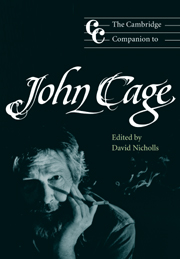Book contents
13 - Cage and postmodernism
from Part III - Interaction and influence
Published online by Cambridge University Press: 28 September 2011
Summary
Postmodernism is best understood as an ensemble of discourses that is not only internally diverse but also contradictory in its relationship to modernism. For postmodernism is both a rejection of modernism, because it jettisons the modernist fascination with system and form, and a transformation, in the sense that it reveals aspects of modernism that were previously undervalued. Given that the range of influences which contributed to the career of John Cage is as tangled as the diverse currents that feed postmodernism, it is not difficult to find parallels between Cage's aesthetics and the postmodernist ethos. Add to this Cage's apparent appetite for unresolved paradoxes, and it is tempting to argue that this is the sense in which Cage is most consistently postmodernist. However, not all Cage's contradictions are postmodernist contradictions. Indeed the difficulties presented by trying to decide whether Cage is modernist or postmodernist, demonstrate just how hard it is to draw a rigid line between the two mindsets.
Before considering further the affinities between Cage and postmodernism, it is necessary to map some of the salient features of postmodernism, while noting that Cage's activities are not only described by this category but also contribute to its formation. The postmodern response to the rationalizing processes of modernity falls into two main strands. One offers an intensification of modernity, drawing on the energy of post-industrial new technologies and comfortably inhabiting the increasingly manufactured worlds we have created. The other strand counters the incursions of technocratic systems on nature and communities and is characterized by, for example, the ecology movement and new-age beliefs. Of course, there are many shades and variations of opinion between these hyper-modern and anti-modern extremes.
- Type
- Chapter
- Information
- The Cambridge Companion to John Cage , pp. 227 - 241Publisher: Cambridge University PressPrint publication year: 2002
- 4
- Cited by



